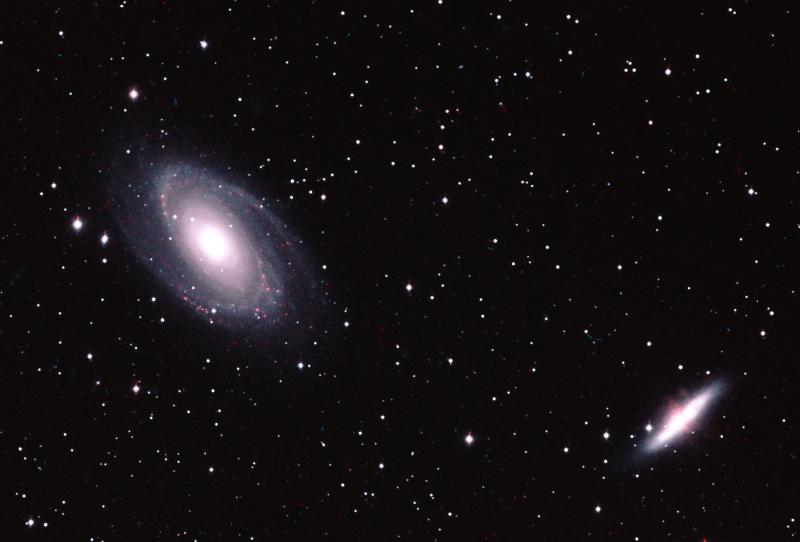2019 March 24
Observer’s Challenge – M81 and M82


Appearing in Messier’s catalogue as numbers 81 and 82 they were actually discovered by the German astronomer Johann Bode (of Bode’s law fame) in 1774 and then independently by Messier’s colleague, Pierre Méchain, in 1779.
Having two bright galaxies visible together is special enough, but what makes this pair extra special is their contrasting types. M81 is a spiral with a very active nucleus and massive black hole at its centre, appearing egg-shaped through most amateur telescopes, while M82 is a glorious cigar shaped dwarf irregular star-burst galaxy (although classed as irregular, in 2005 near-infrared images showed 2 faint spiral arms). Both galaxies lie around 10 million light years distant, although references vary significantly on this. It is thought the two interacted with each other a few million years ago causing the disruption now seen in deep images. Bob Winter’s image shown here, taken through his Takahashi refractor from a dark site in Wales, shows the contrast between the galaxies very well.
Although both are circumpolar, they are best seen in the spring when they are high in the sky. Depending on what telescope type you observe them with though, you may find your neck muscles need a visit to a physiotherapist to be put back in working order after a prolonged viewing session! M81 lies at RA 9h 55.6m and Dec +69deg 04min but a good way to locate it, certainly if using binoculars or a finder scope, is to project a line from gamma UMa through alpha UMa (both part of the bowl of the Plough asterism) and continue for a similar distance until you approach mag 4 star 24 UMa. The galaxy pair lie around 1.5 degrees before you reach this star.
So what can you see and what are the challenges? M81 at mag 6.9 and M82 at mag 8.4 should both be visible in 10×50 binoculars, unless you live under very poor skies. You should see M81 as a small oval fuzz and M82 a thin faint streak. Very similar to the description Charles Messier gave after viewing them in 1781. Galaxy visibility is notoriously dependent on sky transparency so if you fail to see them wait for a better night – although one of the problems of deep sky observing in the UK is that you seem to spend all your time waiting for a better night!
The two sketches shown here were made by myself through a 14-inch (35cm) Dobsonian. Although both galaxies fitted easily in a 1 degree field of view I chose to sketch through a 30 arcmin field to show more detail while still keeping an attractive star field. In a 15cm reflector the bright core of M81 should be clear and elongated while increasing the aperture to 25 or 30cm will show hints of structure in the halo and a small but not quite stellar nucleus.
Although the spiral arms image relatively easily they are a difficult visual target. The problem for visual observers is to not see what you know to be there. Even in a 40cm reflector faint streaks of nebulosity will be seen outside the halo and it is only too easy for your brain to join up the dots and produce spiral arms. Use averted vision on this faint outer nebulosity and try sketching what you can see along with the star field. Only then compare it with a photograph.
Stewart L Moore
Stewart is a former Director of the BAA Deep Sky Section. He is a keen visual observer who prefers using a pencil and paper to a CCD and computer.
[Thumb nail image: M81 and M82 imaged by James Dawson]
https://britastro.org/wp-content/uploads/2019/03/M82-Moore-copy.JPG
https://britastro.org/wp-content/uploads/2019/03/M81-Moore-copy.JPG
| The British Astronomical Association supports amateur astronomers around the UK and the rest of the world. Find out more about the BAA or join us. |
